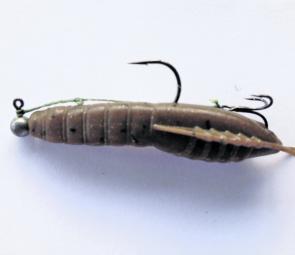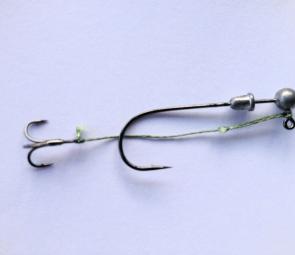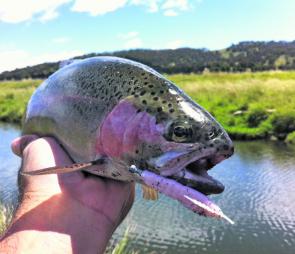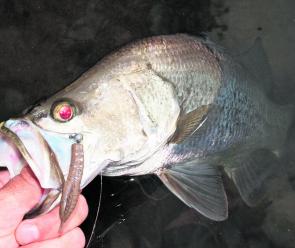Every few years a product comes along that surpasses expectations of what can be done. The Ecogearaqua range is at the leading edge of such design with the release of the Bream Prawn.
Ecogearaqua is a ‘soft bait lure hybrid’, which means it is an infusion of a soft plastic lure with their powered bait technology (Marukyu base product) in the Aqua material.
The purpose-built Bream Prawn range is designed for Australian bream fishing. And it has already racked up a capture list as long as your arm. In this article I will unravel the technical advances involved in production of this new hybrid soft bait and also give an insight into some of the country’s best anglers Bream Prawn techniques.
JML Trading is the Australian distributors of Ecogear products and last year announced the release of the first purpose-designed soft bait hybrid for the Australian bream fishing scene.
Ecogear has been researching and developing the Aqua material for 20 years and the JML R&D team has worked with Ecogear Japan to develop the Australian Bream Prawn over the past three years. Key factors like taste, texture, shape, colour, size and internal strength has had direct input from Australia.
The Ecogearaqua Bream Prawn has been scientifically formulated to attract and deceive Australian bream into eating this biodegradable bait. The material is infused with bream-attracting amino acids that leach out of the lure creating a scent trail to guide fish to the bait.
The Ecogearaqua is a water-based polymer that acts much like conventional plastic materials but will breakdown with natural influences creating a true biodegradable material. Ecogearaqua products have been successfully tested in Japan and Australia on fresh- and saltwater species during the development stages of the 3” Bug Ant, Milfle and Bream Prawn.
I know this is a lot of technical mumbo jumbo but it’s all leading to why this product works so well. The Bream Prawn’s porous material allows the release of a potent amino acid flavour trail that guides the bream to the actual bait.
The Bream Prawn has deliberately been made soft and slimy to allow the release of the amino flavour trail into the water, and its soft texture also allows the most natural feel in a fish’s mouth. Bream Prawns also have an internal fibrous core that acts as a binder and allows better connection to jig hooks.
Ecogear has researched and developed the procedure to extract the key amino acids found in nature that stimulates or triggers our Australian bream species into feeding. Amino acids are the building blocks for proteins and work like a smell or scent in the water. It is these scent trails, made up of amino acids that bream become responsive to once they lock on to the scent leaching out of the bait.
Amino acids can be linked together in varying sequences to form a vast variety of proteins. These proteins make up the base of flavour essences such as vanilla, strawberry and aniseed, all of which have been used in attractants around the world.
Aniseed has long been a favourite for bream anglers. Proteins are also necessary in animal diets, since animals cannot synthesize all the amino acids they need and must obtain essential amino acids from food. Through the process of digestion, animals break down ingested protein into free amino acids that are then used in metabolism. For example, the most abundant of these occurring in nature is the L-Glutamic acid. This is also the infamously effective taste enhancer monosodium glutamate or MSG.
Smell is an important sense for many fish. Those little holes that look like nostrils on a fish are called nares. Nares don’t lead to the throat the way nostrils do in mammals, but open up into a chamber lined with sensory pads. Some fish can pick up chemical signals when immobile by pumping water through their olfactory system via tiny hairs called cilia. Bream have this ability to hover over soft baits and taste the attractants without making any contact and this can give bream an upper hand over the angler.
For years I have described the initial small tap from a bream investigating a soft plastic as them having a sniff and a lick and the science behind fish senses and the research used to produce the Bream Prawn proves it.
Their acute sight also adds to the complex group of senses available to a wary bream, hence the need for a convincing string of amino acids to stimulate the urge to feed. When the sensory pads pick up chemical signals, they transmit them to the fish’s forebrain, which interprets the signal and incites the fish to respond appropriately.
In the case of the Bream Prawn the amino acids or chemicals signal food and the bream reacts by attempting to eat the Bream Prawn rather than mouth it.
The Bream Prawn has been designed to be fished very slow, allowing the flavour trail to attract the fish to the bait. This technique is known as ‘dead sticking’ and consists of fishing the BP very slow and with limited action imparted to the soft bait.
Once the bream’s senses pick up on the flavour trail and visual contact is made, the following bite on the soft textured bait releases a concentrated burst of the amino acids convincing the bream that the bait is food and the bream commits to a full feeding attack on the soft bait. This commitment to the strike means the angler has more chance of the hook finding a purchase point somewhere in the mouth of the bream. This technique is very effective when targeting fish holding deep where a reaction bite is less likely.
Ecogear Pro Staffer Adrian Neoh is a competitive angler on the bream tournament scene and has refined a stinger rig to suit the Bream Prawn and its soft texture.
The main reason Adrian use stingers with Bream Prawns is that it helps prevent the plastic from being sucked clean off the hook. This is due to the soft texture required to effectively leach the amino acids from the lure. It’s these ingredients that keep fish coming back for another bite, but it is the same ingredients that give it its softer texture.
A stinger combined with the skip-in-the-shade jighead provides the most effective presentation of this softer plastic, keeping it on the hook and allowing fish to return for more. Stingers are easy to tie, and they allow the angler to have a heap of them ready to go.
While there are several ways to rig up stingers, Adrian prefers to use a 6lb dark green braid. He got sick of losing fluorocarbon rigged stingers every time a tailor or flathead took the Bream Prawn, which at times can be the bane of a bream angler. He is yet to find fish put off by the dark line along the prawns back.
A simple double granny knot to form a loop at one end, large enough to slide the treble through later, and the treble or octopus-style hook tied to the other end and it’s all done. The hardest part is getting the length of the braid right it needs to be long enough to reach the end of the plastic without too much slack. With some practice, it becomes easy to judge. While the stingers may lead to an increased hook-up rate, keep in mind the potential for stingers to be un-retrievable should a fish inhale the plastic deep enough.
Ecogear Pro Staffer Scott Whitfield has been discovering the effectiveness of Bream Prawns on highland trout and has an effective technique to tempt these freshwater icons.
Trout really test light tackle with their hard hits and acrobatic fighting style. These fish never give up and fight the whole way until they are landed. In the earlier days you were very limited with the artificial baits you could use to target their fish. A lot of trout anglers used to use, and still do use, lightly weighted fly rods and flies to imitate or mimic what the trout are eating. These days, with the introduction of Japanese technology, you don’t need to have heavily weighted lines to cast your small imitation baits.
Trout love eating small shrimps, insects and insect larvae and when Scott first got a look at the Bream Prawn he noticed that the colours and size looked a lot like a small shrimp and a dragonfly larvae called the mudeye. When he finally got his hands on few packets of Bream Prawns he went back to the New England area to test them out on the local trout population.
The outfit that Scott likes to use is a 7’6” 3-8lb rod with a 2000 size reel with 6lb Yamatoyo fluorocarbon line. The longer rod helps to get more distance when casting the lightly weighted lure. The type of jighead that you use is very important when fishing with these lures. The Skip in the Shade jighead really does marry up well with the Bream Prawns, allowing the bait to stay on the jighead a lot longer.
Scott likes to use a size 1, 1/16oz jighead. The lightly weighted jighead doesn’t sink as quick, which helps to keep the Bream Prawn at a good level in the water and looking a lot more natural when retrieved slowly.
Make sure you keep the bait moving and softly bounce your rod tip throughout the retrieve and maintain a tight connection as the bait drifts through the flowing water. Keep the rod tip low to the water and point it in the direction of the bait to maximise hook-up rates when a fish strikes. Keeping the rod tip low also alleviates the potential to spook the fish due to their excellent eyesight.
First things to look for when approaching a stream is any signs of movement on the surface, then look to the weed edges and drop-offs as the trout will be hunting up and down these spots. Another good tip is not just to focus on the bigger water holes as a lot of big fish are caught in streams no wider than 1m by 300mm deep. More often than not they are sitting in the rapids ready to ambush any food as it comes past them.
ABT Pro Angler Steve Morgan recently found a niche for the Bream Prawns in his tournament technique arsenal.
At the Mallacoota BREAM Qualifier Steve had plenty of bream coming up to look at his pink grubs, but when the bait was paused, they'd often reject it. Quick to find a solution to remedy this he swapped to a 50mm Bream Prawn on a single, unweighted worm hook in a size 1/0. Casting close to the bank, he’d swim the bait out from the bank along the surface, and when a bream followed, he simply dropped it back to it.
The conversion rates on Bream Prawns were much higher than the previous lures and Steve could only assume this was because of the smell and taste of the baits.
Due to the clear water, Steve needed to fish them on 3lb fluorocarbon, and set the hook hard to secure bites. Mudding fish loved this rig, too. He would see a discoloured patch of bottom where the bream were feeding, drop a Bream Prawn into it and they'd usually eat it straight away. Again, it was important to set the hook hard.
Black and yellowfin bream both consistently ate it. It's a real producer when the fish are a little shy.
Steve pretty much summed it up when he said, “I use it because it works”.
BREAM PRAWN
The Bream Prawn comes in two sizes – 40mm and 50mm. JML will release 8 colours in the initial launch with many more already being tested for the coming years. At present, Ecogear Japan can only make single colour schemes but this may change as the development of the product continues.
Reads: 4578











